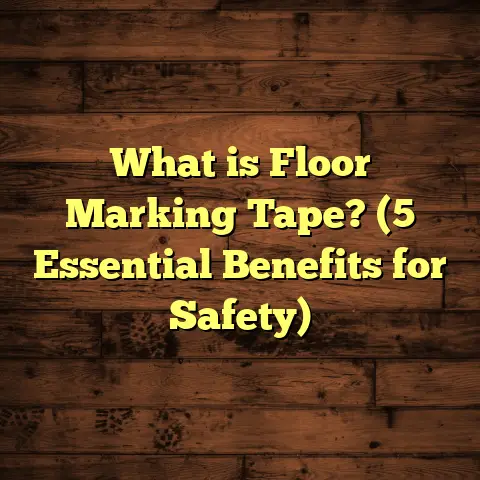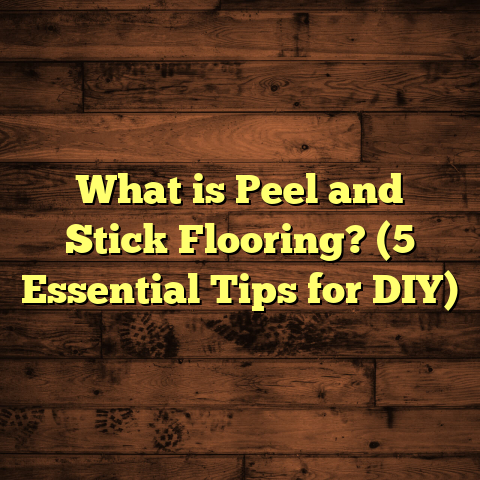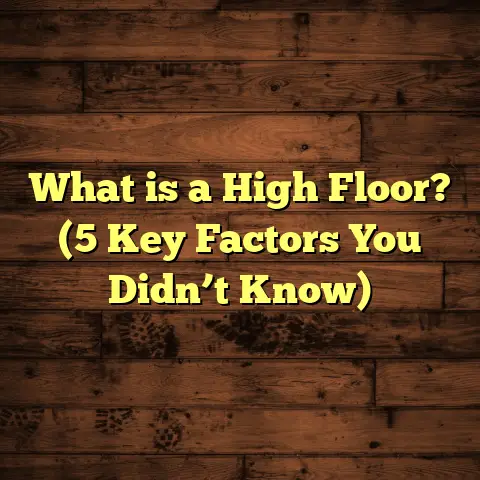What is Teak Flooring? (5 Reasons It’s the Best Choice!)
I still vividly recall the moment I first saw a fully finished teak floor in an old colonial home. It wasn’t just the color or the grain that caught my attention—it was the feeling underfoot, the way the wood seemed to breathe life into the space. That experience sparked my deep appreciation for teak flooring, which has only grown over years of working with it on countless projects. If you’re like me—someone who cares about quality, beauty, and longevity—then teak flooring might just be your best bet. Let me walk you through why.
A Floor That Tells a Story
Have you ever walked into a room and felt an instant connection? That emotional pull is what teak floors bring to a space. They’re warm, inviting, and have a natural elegance that hard-to-match materials simply can’t replicate.
But beyond beauty, teak floors offer practical advantages that keep them standing strong in homes and businesses worldwide. I’m going to share with you five main reasons I’ve come to trust teak as my go-to flooring choice—and why it might become yours too.
1. Durability That Can Handle Real Life
Let me ask you: How often have you wished your floors could just take whatever life throws at them without showing wear and tear? Kids’ spills, pet claws, heavy furniture—these all test the strength of any flooring.
Teak’s durability is legendary. This is one of the hardest tropical hardwoods available, with a Janka hardness rating around 1,070 pounds-force, putting it in the same league as classic hardwoods like red oak and maple. But what really sets teak apart is its natural oils. These oils act as a built-in defense system against water damage, insects, and rot.
I’ve installed teak floors in various environments—from dry urban apartments to humid beach houses. In each case, the floor has stood up remarkably well. For instance, in a coastal property where salty air and moisture are constant challenges, teak flooring remained stable and beautiful after years without warping or significant discoloration.
The wood’s natural resilience means fewer repairs and refinishing over time, making it a cost-effective long-term investment despite a higher upfront price.
2. The Look That Grows on You
When I first worked with teak floors, I was amazed at how adaptable they are to different interior styles. The golden-brown hues and fine grain pattern add warmth that can soften modern minimalism or complement rustic farmhouse charm.
One of my favorite projects involved installing matte-finished teak planks in a contemporary loft. The wood’s natural character brought texture and depth to an otherwise industrial space filled with steel and concrete. The client was thrilled because the floor didn’t just fill a functional need; it elevated the whole vibe of their home.
Teak also ages beautifully. Unlike some woods that dull or darken unevenly, teak’s color deepens gracefully over time. If you leave it unfinished outdoors, it develops a silvery-gray patina that many designers seek for its weathered look. Inside your home, regular maintenance keeps its rich tones vibrant for decades.
3. Installation That Fits Your Style
Are you worried about complex installation? Don’t be. Teak can work with various installation methods, making it flexible for different projects and budgets.
For solid teak planks, traditional nailing or stapling is common. If you prefer engineered teak flooring—where a thin layer of teak is bonded over plywood or fiberboard—there are glue-down or floating options available. Floating floors with click-lock systems have made DIY installations more accessible than ever.
In my experience, hiring skilled installers familiar with teak ensures flawless results. But even if you opt for a DIY approach with engineered teak, the process isn’t overly complicated compared to other hardwoods.
One tip I always share: acclimate your flooring before installation by storing it in your home for about 7-10 days. This helps prevent gaps or buckling caused by humidity changes after installation.
4. Effortless Upkeep
Here’s a question: How much time do you want to spend maintaining your floors? If your answer is “not much,” teak might be your best friend.
Thanks to its natural oils, teak resists moisture and stains better than many hardwoods, meaning you won’t need frequent sealing or refinishing. Regular sweeping or vacuuming paired with occasional damp mopping keeps it clean and fresh.
From personal experience maintaining my own teak floors, applying teak oil once or twice per year enhances its natural shine without making the surface slippery or sticky. You don’t have to worry about harsh chemicals or abrasive cleaners either—gentle products work best.
In one client’s home with pets and children running around nonstop, these simple maintenance routines kept their floors looking almost like new after five years—no heavy sanding or refinishing required.
5. A Responsible Environmental Choice
Sustainability is on everyone’s mind these days—and rightly so. Fortunately, teak can be an eco-friendly option when sourced responsibly.
Look for teak certified by organizations like the Forest Stewardship Council (FSC), which guarantees wood comes from sustainably managed plantations that protect biodiversity and local communities.
I once worked on a project using reclaimed teak from old shipping vessels—a fantastic way to repurpose beautiful wood while reducing environmental impact. The floors had unique character marks from their previous life but were still incredibly durable and stunning in appearance.
This blend of sustainability and durability makes teak an excellent choice for those who want beautiful floors without compromising their environmental values.
Breaking Down Costs: Is Teak Worth It?
I’m often asked whether the cost of teak flooring matches its benefits. Here’s what I’ve learned from years in the field:
- Material Price: Teak is generally more expensive than domestic hardwoods like oak or maple. Depending on quality and sourcing, prices typically range from $8 to $15 per square foot for solid teak planks.
- Installation: Professional installation usually adds $3 to $7 per square foot depending on complexity and location.
- Lifespan: A well-installed and maintained teak floor can last 50+ years.
- Maintenance: Lower ongoing maintenance costs compared to softer woods reduce long-term expenses.
When you compare the lifespan and durability with other options, the initial investment often balances out over time. Plus, the aesthetic appeal can increase property value—a factor many homeowners overlook but that savvy investors appreciate.
In fact, a study by the National Wood Flooring Association showed homes with hardwood floors sell faster and at higher prices than those without—and high-quality woods like teak score especially well among buyers seeking luxury finishes.
Real-Life Case Studies
Coastal Home Resilience
In a Florida coastal residence I worked on, humidity and salt air created constant challenges for traditional hardwood floors. After installing solid teak planks finished with oil-based polyurethane, the homeowner reported zero issues after three years—no swelling or gaps despite severe weather fluctuations.
This project reaffirmed my faith in teak’s suitability for humid climates where moisture resistance is critical.
Urban Loft Warmth
A client renovating a large industrial loft wanted warmth without sacrificing modern style. We chose engineered teak flooring with a matte finish nailed down over plywood subflooring.
The result? A cozy yet contemporary space blending steel beams with natural wood tones. The client loved how easy it was to maintain given their busy lifestyle.
Reclaimed Teak Project
For a restoration of a historic mansion, we sourced reclaimed teak from dismantled colonial furniture and boat decks.
This floor was unique—each plank told a story of its past life but offered all the resilience of new wood thanks to expert milling and finishing. It was a standout feature that delighted both owners and visitors alike.
Installation Insights From My Toolbox
If you’re planning your own project or overseeing one, here’s what I’ve learned about installing teak flooring:
Acclimation Is Key
Teak needs to adjust to your home’s temperature and humidity before installation—otherwise it may shrink or expand excessively afterward. Store planks indoors for about 7-10 days prior.
Subfloor Preparation
A flat, clean subfloor is non-negotiable for success. Any bumps or debris can cause uneven planks or squeaks later on.
Fastener Choices Matter
Solid teak floors typically use nails or staples designed for hardwoods to hold secure without splitting the wood. Engineered options may require high-quality adhesives or click-lock systems depending on product type.
Expansion Gaps Avoid Problems
Wood expands and contracts naturally; leaving small gaps (usually 1/4 inch) around room edges prevents buckling during seasonal changes.
Finishing Touches
Oil finishes bring out warmth and are easier to touch up; polyurethane offers greater surface protection but can be harder to repair once damaged.
Maintenance Tips That Keep Teak Floors Gleaming
You don’t need to be a flooring pro to keep your teak floors looking great:
- Sweep/vacuum regularly using soft bristle tools.
- Mop occasionally with damp (not wet) cloths using mild detergents.
- Avoid abrasive cleaners or excessive water.
- Apply teak oil 1-2 times annually for luster.
- Place mats in entryways and rugs in high-traffic areas.
- Address spills promptly to prevent staining.
One homeowner shared how these simple steps preserved their floors through three active toddlers and two dogs without major refinishing—even after seven years!
Why I Keep Coming Back To Teak
Over my career, I’ve worked with many flooring materials—each has strengths—but few combine toughness with timeless beauty like teak does.
It’s not just about durability or looks; it’s about how the floor interacts with daily life. Teak invites warmth into homes while standing up to real challenges—from moisture to heavy use—with grace.
I often tell clients: investing in teak means investing in floors that age like fine wine—gaining character without losing integrity.
Final Thoughts: Is Teak Flooring Right For You?
If you want floors that marry function with natural elegance; withstand wear without constant fuss; and offer sustainability when sourced correctly—teak fits all those boxes.
Sure, it requires upfront investment higher than some alternatives—but what you get in return is peace of mind plus stunning aesthetics that last generations.
So next time you’re weighing flooring options, ask yourself: Do I want something ordinary? Or something that feels like home every step of the way?
From my experience—and the stories I’ve gathered from satisfied homeowners—teak flooring answers that question beautifully every time.
If you want me to help calculate costs specific to your project using realistic local rates or discuss installation methods tailored to your home environment, just let me know!
I’m here to make sure you get flooring that not only looks amazing but stands up to life’s demands while keeping your space warm and inviting for years ahead.





